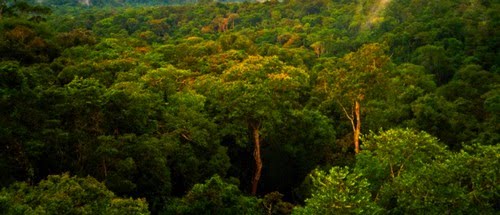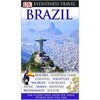Brazilian EcoTourism - Amazon (Amazônia)
by Roberto Mourão
The Amazonian Forest, the world's largest equatorial forest, occupies an area of over 6 million km2 spread over nine countries. Most of it - around 60% - is in Brazil. It is divided into two large halves by the Amazon River, navigable by large vessels for over 6,500 kilometres from Belém in Pará, at its estuary in the Atlantic Ocean, to Iquitos in Peru. A result of the confluence of two of its largest tributaries, the Negro and the Solimões, the Amazon is the main drainage channel in this kingdom of water, where a huge network of rivers, river banks and lakes forms natural roads and covers the largest fresh water reserve of the planet - around 20% of the total. Between the large rivers - or main highways - are the Branco, Jari, Japurá, Javari, Juruá, Purus, Madeira, Tapajós, Tocantins, Trombetas and Xingu rivers.
For intending travellers to Amazonia, the greatest spectacle offered by nature is its exuberant flora owing to the strong connection between the forest and the river. Despite the huge diversity of wildlife, fauna is difficult to see owing to the characteristics of tropical forests. However, the estimated over 2,000 species of fish makes Amazonia one of the main Brazilian destinations for sport fishing and watching ornamental fish. From the cultural point of view, the greatest interest lies in the traditional communities - or forest peoples: rubber gatherers, 'caboclos' (mixed bloods), riverbank dwellers and indigenous communities. Visits to the latter are prohibited.
The best way of getting to know this water world is by means of river cruises, or by staying at one of the various jungle lodges. With temperatures normally above 20 ºC and owing to the characteristics of the humid forest, the best time to visit Amazonia is "summer" - June to October - when the humidity of the area is lower.
Amazonia may be visited from Manaus, a city situated on the left bank of the Negro River, near the confluence with the Solimões River. These two rivers form the Amazon in a natural spectacle of rare beauty, the "meeting of waters", in which the dark waters of the Negro meet the muddy waters of the Solimões and they run side by side without mixing for miles and miles.
Another important way into Amazonia is Belém, the largest city on the Equator, situated on one of the branches of the Amazon River, near its outlet into the Atlantic. The capital of the State of Pará is also near Marajó Island, where there are many possibilities for ecotourism routes along the rivers, channels, riverbanks and mangrove swamps on this island with an area equal to Denmark and larger than the State of Rio de Janeiro.
Other important access cities to Amazonia are Alta Floresta, Boa Vista, Macapá, Rio Branco and Santarém.![]() More on Brazil:
More on Brazil:![]() Olinda - Pernambuco
Olinda - Pernambuco![]() Brazilian Carnival - Rio de Janeiro
Brazilian Carnival - Rio de Janeiro![]() Brazilian Ecotourism - Cross-Walks
Brazilian Ecotourism - Cross-Walks![]() Brazil - Business and Leisure
Brazil - Business and Leisure![]() Arraial do Cabo - Rio de Janeiro
Arraial do Cabo - Rio de Janeiro![]() Costa do Sauipe - Bahia
Costa do Sauipe - Bahia![]() Cultural Interchange - Education Tourism
Cultural Interchange - Education Tourism
December 29, 2007
Brazilian EcoTourism - Amazon (Amazonia)
0
comments
0
comments
|
|

 Welcome to Travel to Brazil.
Welcome to Travel to Brazil.
